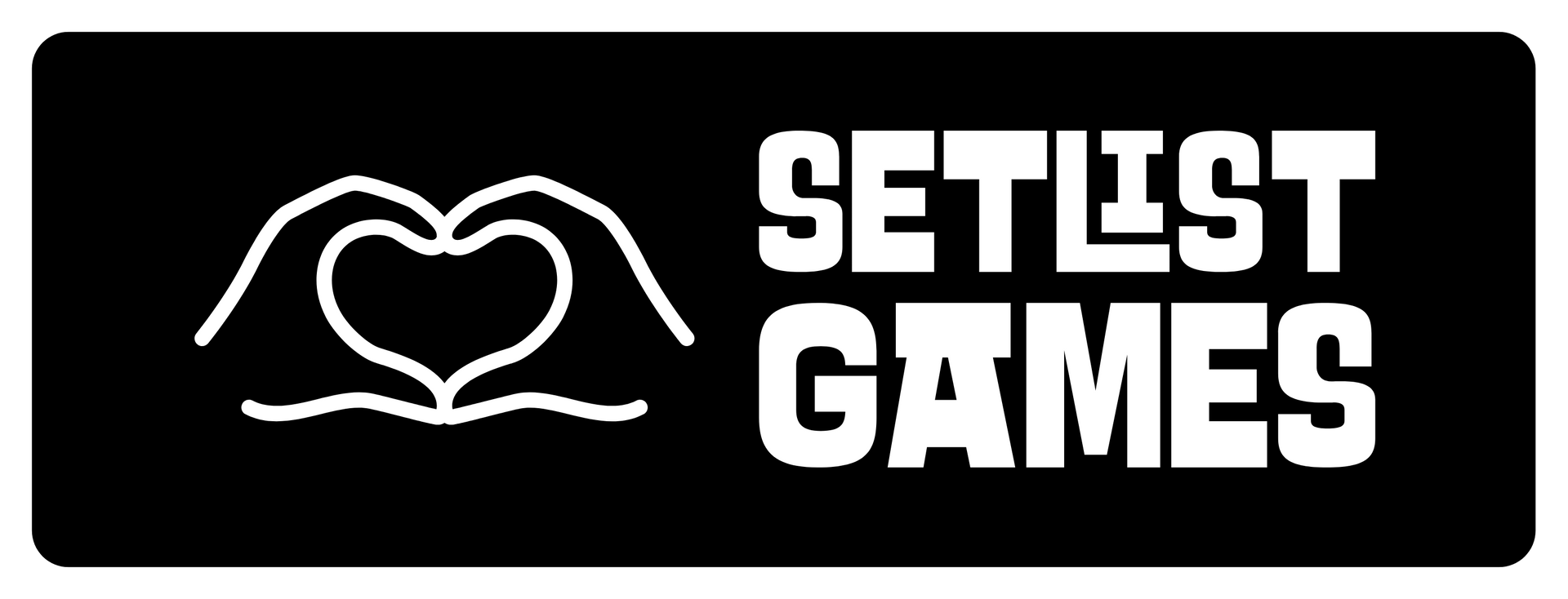How To Play
AKA "THE RULES"
Before You Start
Note that the game rules on this page are occasionally updated based on input from play testers. The retail version will have a printed rule sheet.
Set-Up
Remove the tracking card, Good Karma card, and the player aid cards from the deck and set them aside. Shuffle the remaining cards.
Deal 13 cards to each player. Place the rest face-down as the draw pile. Turn over one card to start the
Trading Pile. The trading pile grows to the side with cards exposed. Place the Karma Cat on the other side of the draw pile.
Put the tracking card where all players can see it and put a sparkly gem on pink square for the Lover Era. Each player picks out another gem to use when in the Merch Line.

- Don't forget to pick out a favorite playlist (like this one) and start some music for the game!
Number of Players
The prototype rules are optimized for 3-4 players. To play with 5-6 players, add all the cards from one booster pack.
See the Booster Packs page for more info.
Determine Who Goes First
The player with the best ticket section goes first. Ranked sections are VIP, then FLR, 100, 200, and 300. The earliest ticket date breaks ties. If no tickets were dealt, the youngest player goes first.
Take Turns
Play goes clockwise. On each player's turn, they Draw, choose an Action (adding to their Collection), and Discard (adding to the Trading Pile).
Winning the Game
Cards added to the Collection contribute to a player's points total. Cards still in-hand are subtracted from the points total. At the end of the game, the player with the most points wins the game.
Draw
Players choose to draw either the top card of the deck or the top card of the trading pile.
Players may also draw from deeper in the trading pile. When doing so, that card must be played in the current turn, and the player takes all cards above it.
When the draw pile is empty, players have the option to skip both the draw step and the discard step.
Player's may not choose the top card from the trading pile and then discard it in the same turn. This seems like a silly rule to state, but trust a clever 10 year old to find the loophole that necessitates this rule!
Action
Choose one type of action per turn. More detail below.
- Use a Ticket
- Play Songs
- Wait in the Merch Line
- Collect Merch
Discard
Choose one card from your hand to add to the top of the Trading Pile. When the draw pile is empty, discarding is also optional.
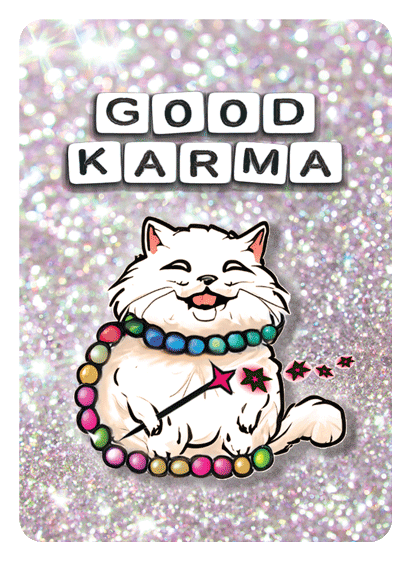
Earning Good Karma
When a player's discard is picked up by another player before it is their turn again, that player earns the Good Karma card. It stays face-up in their collection.... until it is played or passed on.
When played, Good Karma is returned to the center of the table. If earned by another player before being played, it is passed on. Experienced players know all too well to not wait long before activating their Good Karma!
Hint: on your discard step, there's nothing wrong with asking another player what card they might like to pick up, if you were to put it down.
- Player's will find a
list of special actions
they can take on the back of the Good Karma card.
Types of Action
Use a Ticket
The elusive Eras ticket! A player's ticket represents a specific date and venue from the tour. Some other cards will only be playable if they match that ticket.
Players must have a Ticket before they can collect any Songs. And there is a big point penalty for ending the game with an unused ticket in hand... discard your extras and get them out to the Switfties!
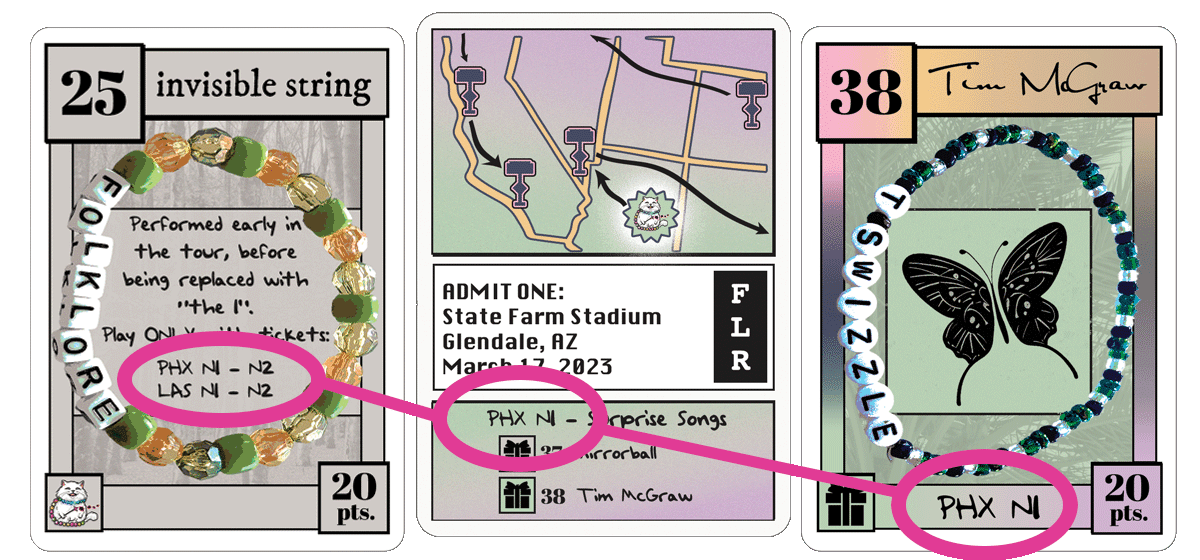
Changing Tickets, aka Ticket Swapping
Players may only have one ticket in their collection at a time, but can choose to replace it with a different one. This is called Ticket Swapping. A player may wish to do this to better align with song cards that they were dealt or picked up.
When swapping, the new ticket is played, and the old ticket is added to the top of the trading pile. This replaces the discard step.
Any songs which were only eligible for play with the previous ticket remain in the player's collection. All song played moving forward must be eligible with the current ticket.
Playing Songs
Songs are played by adding numbered Song cards from a player's hand to their Collection. Songs can be played two (or more) at a time when they are in a sequential run, or as singles when they are building off a run that is already on the table, or both. Players may add as many songs to their collection in a single turn as are eligible to be played.
Duplicate Songs may only be played when they are collected by different players.
At the start of the game, only Lover Era songs may be played. To open the era, play any two consecutively numbered pink Lover era songs.
THE OPENING SONG RULE
A player who has Song #1 in-hand - Miss Americana and the Heartbreak Prince - may play it as a single when it the first song card played by anyone in the game.
Opening Additional Eras
Other eras open in sequence, once the minimum number of Songs for the previous era have been collected (by all players combined). That number differs by Era, as shown on the Eras Order helper card.
Once the minimum has been met, any player can open the next Era by:
- Playing a sequential run of two or more Song cards, both from the next era.
- Playing a sequential run of two or more cards that “bridge” the current era with the next one.
- Playing the single first song of the new Era, as long as the last song from the previous era has been played.

Join the Merch Line
To play Merch cards, you'll first need to wait in line. No worries, it's a party in there! Put the Merch Line card face-up in front of you, and place a gem on the circle with the number "1". This is the first turn in line.
On the next turn, a player in the Merch Line chooses to Collect Merch, Stay in Line, or Leave the Line. Players need to remember that they are in the Merch line and not make another type of play! If you forget and are called on it, your Merch Line card is forfeited and placed in the trading pile.
Players do not draw or discard if they are staying in line.
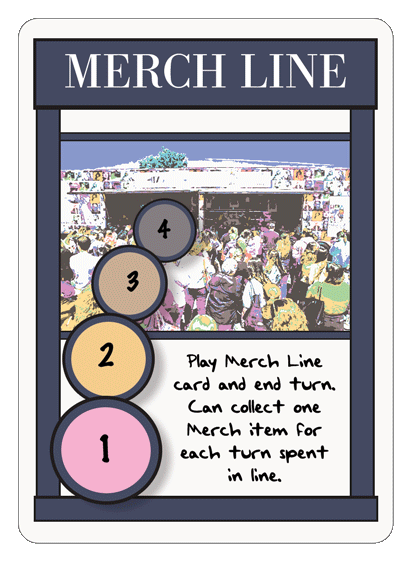
Staying in Line
Swifties who’d like to collect more than one merch item at once need to wait in line for additional turns. Announce that you are waiting in line and move your gem forward one number on the Merch Line card. This is then end of your turn.
Leaving the Line
At the beginning of their turn, players may also announce that they are leaving the line without collecting any Merch. After doing this, it is possible to then draw and take other actions (Swap Tickets, Play Songs, etc.) The Merch line card goes to the Discard pile, but this does not replace the Discard step. Players must still discard after their action.
A player who forgets that they are in the merch line at the beginning of their turn, and who draws or makes another type of play, has been distracted by shiny objects while in the merch line. Their actions are the equivalent of announcing they are leaving the line, and their Merch Line card is their discard.
Collect Merch
Players are eligible to collect one piece of Merch for each turn spent in line. After scoring some of that
sweet, sweet
Taylor merch, the Merch Line card is moved to the top of the trading pile. This is the Discard step, and the player ends their turn.
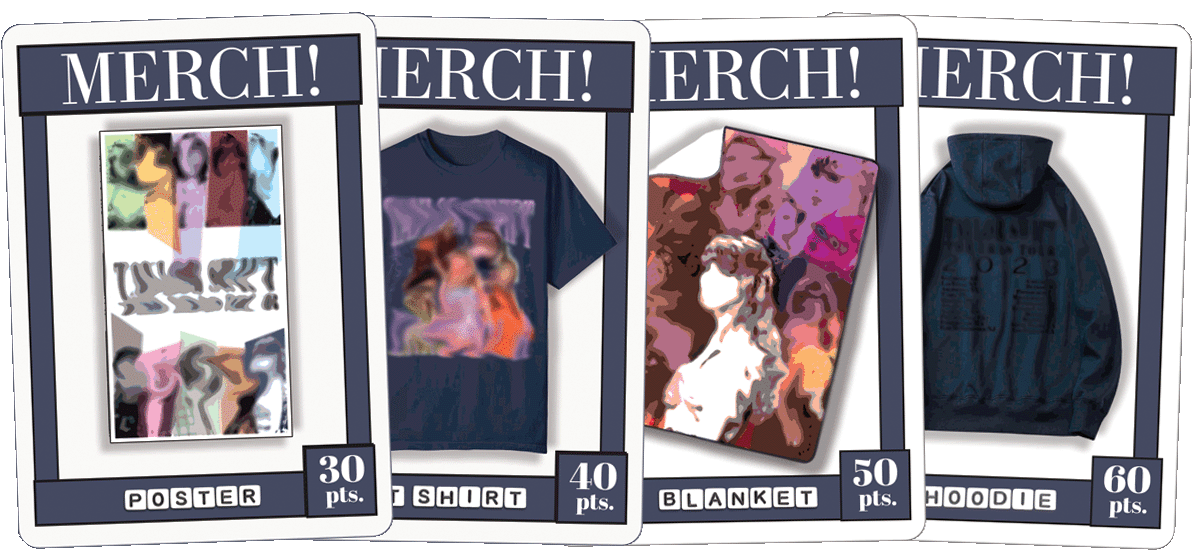
Discard
Discards are always added to the top of the Trading Pile, which is face-up and staggered so that other players can see each card in the pile. Players may always look through the discard pile to what is there.
Be sure to keep an eye on your most recent discard. If another player picks it up before it is who turn again, you earned Good Karma!

Welcome to the Acoustic Set!
After the minimum number of cards from the 1989 Era have been played, players may Collect their matching Surprise Songs. After any player collects a Surprise Song, each other player has two turns to play their own Surprise Songs They can be played separately or together. When these turns are up, the Midnights era is open.
After these two turns are over, Surprise Songs may no longer be played. Collect them while you can!
Hint: the Surprise Songs, with their present icon in the lower left, are usually #37 and #38 and the deck, but do stay on your toes for special triplets and mash-ups!
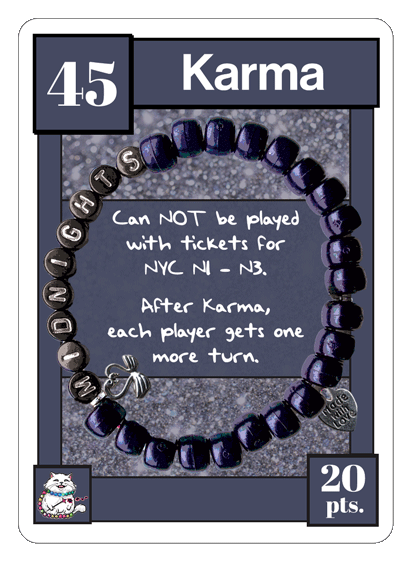
Midnights and End of Game
The Midnight Era is sure to fly by, and when someone collects Song #45 - Karma - you know it's almost the end. Each player gets one more turn, then the show, er..... game.... is over.
Now players bask in the after-glow while collecting confetti and counting up points. The player with the most points wins.
Scoring
Cards in a player's collection are added to their points total:
- Add the points value of all Song and Merch cards and Merch cards in your collection
- Add 40 bonus points for having a Friendship Bracelet from every Era (not including self-titled)
- Add 40 bonus points for ending with Good Karma in your collection
Cards in a player's hand are subtracted from a player's total:
- Subtract the points value of all Song and Merch cards still in hand
- Subtract DOUBLE the point value for any Surprise songs in hand
- Subtract 60 penalty points for any Tickets still in hand
Breaking Ties
In the case of a tie:
- If one of the players ends with Good Karma, that player wins the tie.
- If neither has Good Karma, the player with the most Eras represented in their collection wins the tie.
- If still a tie, the player with the most points in Merch wins the tie.
Rules FAQ
Q: Can players get in the Merch line before playing a ticket?
A: Was there a Merch booth in the parking lot? You bet there was! Players may definitely choose to enter the Merch line before they play a Ticket card.
Q: Can players get in the Merch Line in the same turn as playing Song or Ticket cards?
A: Nope! Finding the end of the line to the closest merch booth takes some time. The Merch Line card is played first, and that ends the player’s turn.
Q: Can a Swiftie play a second Ticket?
A: Players may only have one ticket in their collection at a time, but can choose to replace it with a different one. This is called Ticket Swapping. Swifities may wish to do this to better align with song cards that they were dealt or picked up.
After putting down a new Ticket, the previous Ticket is added to the top of the Trading pile. Ticket Swapping is their play for the turn.
Q: Can I play a song card from an Era that has passed?
A: Once an Era has been opened, Friendship Bracelets from that Era may continue to be played throughout the game.
However, this does not include surprise songs, which must be played during the Midnights era! When collecting friendship bracelets from previous Eras, play must still follow the rules about cards being in sequence.
Q: Can duplicate Songs be played?
A: Some songs are represented in the deck more than once. A duplicate Friendship Bracelet may be played, but NOT by the same player who has already played it.
Q: Can a sequential run of songs go across Eras?
A: Yes! This is called "Bridging Eras".
And since you asked, the song card in the beginning of the a bridge DOES count towards the minimum number of cards needed to open a new Era. By playing bridges, it is possible to complete the minimum and open the new era... all in the same turn.
Q: If Good Karma is used for an end-of-game bonus turn, does that player still draw?
A: Yes, that player still draws. At the end of the turn, Good Karma has been played and is returned to the center of the table, so the bonus points for ending with Good Karma "in hand" sacrificed.
Still Have Questions?
We're here to help! Send an email, message on our socials, or join our Player's Group on Facebook. See you there!
